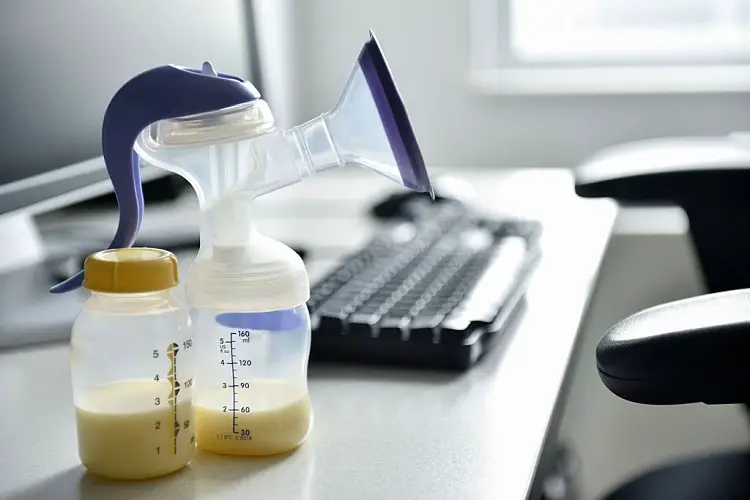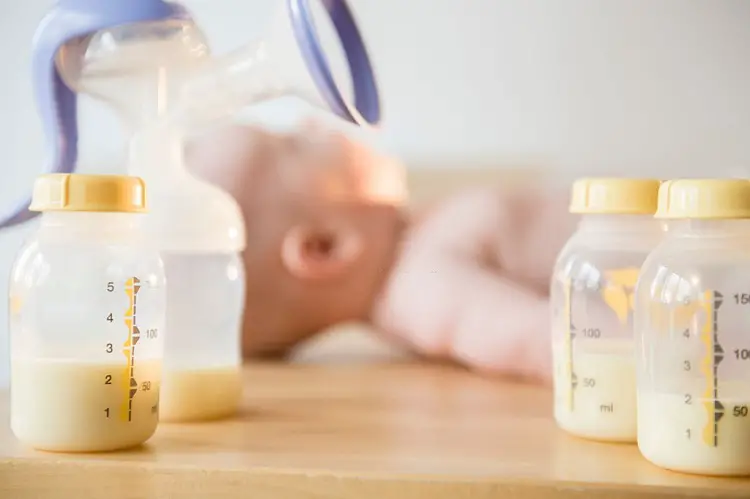No matter the bond formed during and after Pregnancy, there comes a time when mothers have to part ways with their babies, and for some, daycare is the beginning of such a time.
Trying to gather your life back together, get back to work, and do other things aside from breastfeeding your baby will require you to drop him off at daycare if there’s no other trusted adult to look after him as you would.
And this may have you wondering how much milk to pump for daycare so as not to have your baby underfed while he’s away.
How To Pump Milk For Daycare?
You should start pumping milk to stock your freezer. This could take anywhere between two and four weeks.
It is possible and normal to only pump half an ounce to two ounces per pumping session if you are breastfeeding.
If you pump an ounce per pumping session and pump twice a day, you will have fourteen ounces in the freezer after seven days, which should be enough milk to last your child through their first day of daycare if you’ll be unavailable for 8-10hrs.
Thaw the frozen milk in the refrigerator the day before your baby’s first day of daycare. When the milk has thawed, pour it into bottles to be fed the next day.
A typical example could be that your child will drink frozen (thawed) milk on Monday. Your baby will drink the milk you pumped on Monday on Tuesday. Your child drinks milk pumped on Tuesday, Wednesday, and so on.
Place your pumped milk in the freezer on Friday. Sunday, thaw milk for Monday’s daycare bottles.
Use this trial run to ensure that your baby does not have trouble drinking frozen milk before their first day of daycare. It’s also a good idea to practice at home.
How Much Milk To Pump For Daycare?

The idea that your baby is going to be away from you for a couple of hours can make you anxious about the things to get ready with, the number of diapers required, how much milk to pump for daycare if you plan to drop him off at daycare and what to expect.
As the mother you are, the nurturing part of you will always try to go beyond the necessary to ensure that your baby is safe and comfortable.
But when it comes to pumping milk for your baby, you don’t need to be extra with it because your baby will likely consume the same amount of breast milk it does at home, so you have very little to worry about.
However, in trying not to be extra, do not pump too little that is not enough for your baby. By the time your baby is ready for daycare, you must’ve taken note of his feeding pattern to know how much milk it consumes and at what intervals.
Best believes that his feeding pattern will not automatically change when he begins daycare.
Babies usually consume about 1 to 1.5. ounces of milk per hour. Going by this calculation, multiply it by the number of hours he’d be at the daycare and give an allowance just to be on the safe side.
For instance, if your baby consumes 1.5 ounces of milk per hour and he spends about 5 hours in the daycare, you will have to pump between 7.5 to 10.5 ounces of breastmilk for daycare.
Although it is good to pump more milk than he usually takes to be on the safe side, be mindful of pumping too much milk because the more milk you pump, the more milk your breast produces, which can cause discomfort.
Read Also: How To Store Formula Milk For Daycare
When To Start Pumping For Daycare?
The best time to begin pumping for daycare is two to four weeks before the first day. You may need to pump several times daily if you are nursing full-time.
You need enough milk to cover one day at daycare, at the very least.
If you are exclusively nursing, ask a lactation consultant about waiting until six weeks postpartum to pump to prevent oversupply, which could lead to engorgement.
How To Pack Breast Milk For Daycare
One challenge many moms experience while preparing their babies for daycare is packing up the breast milk. If you’re one such woman, these tips should guide you in packing up for your baby.
- Your breast produces more milk in the morning, which is supposed to be a good time to pump it, but the same reason you had to enroll your baby into daycare is the same reason you would have to pump the milk the night before, mainly if your breasts don’t produce much milk at a time.
- Wash the feeding bottles and sterilize them in hot water. You can either air dry or clean them with a neat dry towel.
- Pump the milk into the bottles and refrigerate it in a cooler until the following day.
- Have labels with your baby’s name and paste them on the bottles to avoid a mixup. You can also paste them the same night you pump the milk if you can afford to.
- Put a pack of ice inside the cooler alongside the milk bottles the following day, and your baby’s milk pack is ready. While doing all of this, ensure always to wash your hands and sterilize the utensils you’d be using not to contaminate your baby’s food.
What If I’m Not Pumping Enough Milk For Daycare?
Perhaps due to the frequent demands from the daycare to supply more milk, you realize that you’re not pumping as much milk as you should.
This could be normal for some women, but if this is new to you, there could be a few reasons you’re experiencing a sudden dip in breast milk production.
Stress during the day
Your body may react to stress so much that the estrogen and progesterone hormones are affected.
While this may not affect the quality of milk produced, the quantity will be affected. Getting enough rest during the day can boost your milk production.
Dehydration
Not staying hydrated is another cause of reduced milk production because water is required to enhance blood flow, reducing the chances of blood pressure. Drinking a lot of water will go a long way for you and your baby.
Not feeding well
Poor feeding can also alter the process that goes on in your body. For instance, if you consume more fatty and sugary foods, your body has little to gain from them – no energy for your breast to produce the quantity of milk required.
Include many Proteinous foods and vegetables into your meals and stay hydrated. This will increase your milk production and boost your immune system.
Read Also: How To Refill Your Milk Faster
Other FAQ’s
How to make pumping easier
The easiest way to pump is with a hands-free pumping bra. I recommend you check out this Sublime bra found here because of its high quality.
Another exciting baby item, especially at work, is cooler to store your precious breast milk. I highly recommend this cooler bag because:
- It is freezable, so you don’t need extra ice packs
- The bag fits milk bottles perfectly and is inconspicuous
- It can also be used as a lunch bag after you’re done pumping.
How to know if daycare is overfeeding your baby
If you’re curious about whether your baby is being overfed, here are some things that suggest a baby is being overfed.
- Since babies have no other way of communicating their concerns, the best they do is cry. An overfed baby tends to cry every time. If your baby is being fed at the slightest wail, he’s being overfed.
- The method of feeding the baby can also indicate that he’s being overfed. The best way to feed a baby is through pace-feeding, which means holding the bottle parallel to the ground such that your baby draws the milk sufficiently. If the feeding bottle is kept directly to your baby’s face, he’s being overfed.
How to pack breast milk for daycare
Before packing breast milk for daycare, you should clean and dry the bottles. Fill the bottles with milk the night before.
Label your child’s bottles with a high-quality label. Refrigerate the filled bottles the night before. Then add an ice pack to the cooler in the morning.
Always pack your child’s daycare bottles to avoid accidentally spilling your milk by the daycare workers.
Related Posts:
- How to Use Medela Breast Pump (10 Easy Steps)
- Why Is My Breast Milk So Watery (4 Things You Can Do)
- Why Your Breast Milk Smells Like Vinegar (Explained)
Take-Home
How much milk to pump for daycare is not too different from how much milk your baby consumes on a normal day. But to avoid taking chances, pumping a little more than required is sufficient to carry him through the hours you both spend apart.
